SHANNON MUIR: TWENTY-FIVE YEARS SINCE THE DENUBIAN GALAXY STARMAP WAS FIRST RELEASED ONLINE
Shannon Muir (also known by her married name Shannon Muir Broden) has been a Voltron fan since the premiere of Voltron: Defender of the Universe in 1984. She strongly believes that her experiences as a fan of the show, and ultimately finding the confidence to reach out to production company World Events Productions several times over the years, played a strong role in her being encouraged to become a professional in animation writing and production. In 1996, she moved to Los Angeles, but not before deciding to release online her detailed Voltron notes, including her best attempts to “world-build” for Voltron based on what had appeared in the show. Part of those notes detailed a theoretical “starmap” of the Denubian Galaxy, in which the Lion Force Voltron episodes took place. World Events Productions would later ask her to partner with them in the creation of a map for their Voltron: The Third Dimension website in 1998. Shannon hopes that sharing the story of her journey will be an encouragement to others in theirs.
Greg Tyler: Shannon, thanks for agreeing to do this interview.
Shannon Muir: Greg, thanks for having me.
Recently you reminded me that it had been twenty-four years since the premiere of EXTREME GHOSTBUSTERS, one of the series I worked on back at my days at Adelaide Productions (part of the now defunct Columbia-Tristar Children’s Television division, now Sony Animation). That, in turn, makes it twenty-five years since I moved to Los Angeles to work in the entertainment industry. When I first appeared on the LET’S VOLTRON Podcast (Episodes 40 and 41), I mentioned creating a Denubian Galaxy Starmap based on my observations as a fan. Later, World Events Productions made the Starmap canon on their website as tie-in for the VOLTRON: THE THIRD DIMENSION television program. They originally discovered it online as a fan website that I put up in 1996, before I moved to Los Angeles. What most people don’t know is that the Starmap existed on paper as far back at the mid-1980s, a decade earlier.
Also, in April of 2021, you and Marc Morrell featured, on LET’S VOLTRON (in Episode 210), a recording I made as part of a tribute following the death of Ted Koplar, the past President of World Events Productions responsible for deciding to take the chance on the Japanese animation that would become known worldwide and for generations as VOLTRON. After that first aired, I received some questions from listeners that I hope that I can answer today. Thank you for this opportunity.
Greg Tyler: When and how did you discover Voltron? What else was going on in your life at the time?
Shannon Muir: I do have to rewind things to a little before VOLTRON’S premiere in 1984 to set this up, because it’s key to know I wanted to be a writer long before VOLTRON came into my life. My father spent 24 years in the Navy, and I lived in Japan and then Hawaii before he retired in the first half of 1984 after I finished sixth grade. I think that’s well known. However, what I don’t talk about is that I never had a lot of friends and ended up a bit of a loner; I think it’s a big reason my younger sister Lesley and I are as close as we are. I hadn’t given much thought to what I wanted to be when I grew up or anything like that either. The only things I really remember that I liked doing was reading and watching animation. Something happened in fifth grade that significantly changed that.
A teacher I really didn’t like assigned us to write rhyming couplet poetry. I dashed off something about a toy store, not thinking much of it. Imagine my surprise when the teacher said she wanted to put my poetry as part of a student display in the Pearl City Mall. I was surprised but didn’t think much of it until the following year, when my homeroom teacher had us write stories weekly using our spelling words, and the ones she liked were read to the class. That teacher consistently read mine to the class, and again I found one of those stories on display for the sixth-grade student work. That’s when I started to get the sense that maybe writing should be something to take seriously. An interesting contrast is that I had a different teacher for reading, and when they brought in a new text and advanced students were to be moved up to that book; I wasn’t chosen and I told that teacher that I should be. She didn’t think so but told me to finish the entire workbook that went with the current text I had and then I could advance. I don’t think she believed I’d do it, but when I came back with a completed workbook on Monday, she had little choice. I got “C”s at first, but at least I got the challenge I wanted.
Regarding how VOLTRON fits in to all this, VOLTRON premiered in 1984, the same year my father retired from the Navy. We moved to Cheney, Washington, my father had retired from the Navy and was going to college on his GI Bill. At that time, the town had only two stoplights on 1st Street, the main road through town. The population averaged 10,000 people. My Dad’s parents lived an hour away in an even smaller farming community called Ritzville, and other than them (we’d met them in Hawaii when they came once on vacation), my sister and I knew no one.
Greg Tyler: What about Voltron made it appealing to you as a casual viewer and eventually as a fan?
Shannon Muir: When I came home after school, I started out by watching a lot of what was on TV. One of the things I came across reminded me of programs I’d seen when I was much younger in Japan, though I couldn’t understand the context then (the best example is that I remember seeing footage and merchandise for GATCHAMAN in Japan in the late 1970s, and then coming to Hawaii in 1980 and not quite understanding what this BATTLE OF THE PLANETS was that looked like GATCHAMAN – again, such a weird intersection of events, given Franklin Cofod’s hand on both BATTLE OF THE PLANETS and VOLTRON. The show, of course, was VOLTRON. Despite having some awareness of dubbed shows at that age, I did not initially connect that VOLTRON was the same thing. The characters immediately engaged me, and to this day, I think the characters in any iteration are more memorable than the mecha, though admittedly the Lion Mecha is iconic.
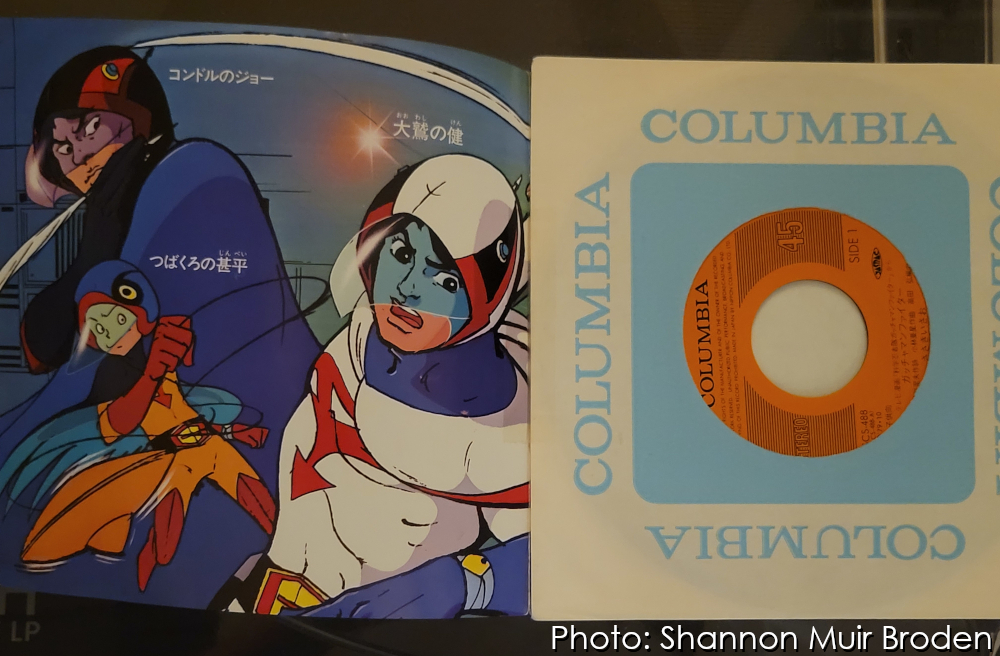
It never crossed my mind that that you might have to know how to draw to write animation (you don’t). I don’t know why it never crossed my mind that people got paid to do this, and that no matter what you dreamed up, a teenager wouldn’t have a chance. What I did know was that I’d been encouraged to write, and I found something I wanted to write about. However, I didn’t have any form of reference, what we would call professionally a series bible. So, by watching the episodes, I cobbled together the information I needed.
You also must know that my sister Lesley and I pushed my father hard to get a VCR. When he was still in the Navy, we were always one of the first families to get new technology. We had the Apple II+ when we lived in Hawaii when home personal computers were not a common thing. However, getting relatively new technology like a home VCR during the VHS and Betamax wars when you might back the wrong format, would be a huge risk for a retired student trying to save all he could for his family. Yet, somehow, he did it. That VCR is what allowed all the VOLTRON episodes to be taped as they aired, though we caught most of the first year in reruns. Watching and re-watching that library of tapes allowed me to take the copious notes that resulted in the Starmap. I’ve never stopped to think until now how my Dad’s love and support, which I’ve always had, made things possible for me even back that far. It’s humbling.
Even though I grew up being exposed to so many Japanese mecha shows, the VOLTRON characters spoke to me, and one did more so than the others – Lance. He and I had a lot in common, most of all being loners, and because of that easily misunderstood. Hunk and Pidge were best buddies, and as much as all the guys looked at Allura, clearly Keith would win there at the end of the day. The more episodes that came out, the more I couldn’t help but feel sorry for Lance and the fact he was by himself. No one seems to understand him, something that sadly I found to be the case when listening to the recent “Flash Form Go” LET’S VOLTRON Podcast (in Episode 214).
Greg Tyler: Your perspective on Lance from “Flash Form Go” would have been great to have during the review. Some of us felt that he was acting a bit out of character in that episode.
Shannon Muir: Let me start out by saying I clearly have a lot of “head canon” with Lance, which I’ll touch on in a minute. However, laying all that aside, the characters in VOLTRON FORCE are generally treated as spiritual if not actual successors to DEFENDER OF THE UNIVERSE characterizations, depending on your perspective. I would argue it tracks for THIRD DIMENSION Lance as well. What I am about to say fits all those. VOLTRON: LEGENDARY DEFENDER doesn’t apply here because that is a different Lance altogether.
The DEFENDER OF THE UNIVERSE show does characterize Lance as very moody. Lance also tends not to trust people, it’s key to several plots such as the one with Bokar the Cobra Man and the episode involving the Phylos comet in the later shows produced by World Events Productions. However, Lance can be emotional, as best illustrated in “The Deadly Flowers,” the episode with Farla and the Roses of Lyra. Basically, Lance has a heart and rarely shows it, but a lot of people tend to forget that.
Another question that was raised in the podcast was Lance’s need for anger management. The series also tells us a little bit about how he grew up, which may explain things. As we learn in the DEFENDER OF THE UNIVERSE episode “Coran’s Son Runs Amok,” he grew up a farmer, and his childhood home was destroyed by Zarkon. Lance and Pidge have an interesting heart to heart during this episode, where Lance tells Pidge, “I’m not a city boy. I grew up in the mountains. Then Zarkon came and destroyed our homes. I wasn’t a fighter; I was a country boy. I lived in a hut, just like that. Every night I used to count the stars. I never dreamed I’d be flying among them.”
When I analyze between the lines, it seems to me that Lance devoted his whole life to being an ace pilot in the process of wanting to do something because of what happened in his childhood, hiding behind a façade of a cocky attitude and flirting with a number of girls, when truthfully he probably hasn’t had any luck with any of them. As the saying goes, “fake it until you make it,” and maybe after all this time he’s still stuck faking it on all fronts. Also, his self-worth would be tied up in being a pilot and being able to save the universe when he couldn’t save his home. When Daniel (and Vince to a lesser extent) encroach on this in VOLTRON FORCE, he would naturally feel threatened if this is still his sole source of self-worth. Those scenes, and especially the exchanges he has with Allura, feel very much in-character and on-point to me. The scene with the towel where he tells Daniel “do not cross the line” I think is as much about do not cross the line into my personal space and where I feel safe as it is about being disobedient. I’ve rewatched these scenes multiple times, I must admit, after seeing all of VOLTRON FORCE for the first time this year. I would have wanted more of this had VOLTRON FORCE continued, for this iteration’s Lance to get the due he has deserved and continues to elude him, in my opinion. To be clear, I see the LEGENDARY DEFENDER version of him as completely distinct, though was extremely pleased they made him the central character there.
I hope that helps provides a different perspective, and very much encapsulates how I see Lance, and saw Lance even at fourteen. However, since VOLTRON FORCE never drops even a hint of this background, if you have no knowledge of the original show, I can see how this would all seem strange though. I do feel that we needed to get a hint of this background somewhere in the episode, like in that exchange that Lance and Allura have, to have the episode make sense for the audience – assuming, of course, that the VOLTRON FORCE show thinking tracked with the same interpretation of the DEFENDER OF THE UNIVERSE version of Lance.
Greg Tyler: Did you collect Voltron merchandise or create Voltron fan fiction or art?
Shannon Muir: As far as the merchandise goes, we had mainly the Panosh Place items, including the VOLTRON that would fit the playset characters and the Castle of Lions. We did break up the lions of VOLTRON for the set we had, and for some reason I only have Yellow Lion and the Spinning Laser Blade. For figures, I have the Doom Commander, King Zarkon, Keith, Allura, Lotor, and Lance. All of those items are here in storage at my apartment, and I took a photo of them since you asked about what I have. I also have a complete set of VOLTRON: THE THIRD DIMENSION characters that are still MIB. This photo is just the Panosh Place ones.

Now, I’m sure you’re wondering what is that next to Lance in the photo. While never a great artist – thank goodness I’m married to one! – I would try to draw any character that my sister and I wanted to create to be part of our larger play environment. Lesley is about three years younger than I am, so I still played with dolls and figurines a little longer than most people that age do; I’ll admit that.
The character next to Lance is named Nina. We just went over how I viewed Lance, and that is key to why Nina was created to begin with. To use a term I encounter in fan fiction, she would have been my “head canon” of the time – though I feel odd saying that as my hope was to be taken seriously professionally. She became a fresh lens from which to view the existing dynamics of the characters. She’d be a new female best friend for Allura who was more like Allura wanted to be and less like what Coran and Nanny wanted her to be; I hate to say “bad girl” influence but that’s what comes to mind. Nina’s strong fighting skills and her Arusian ties would be intimidating to Keith, as arguably she could contest him for power. I promise I’ll explain that more in a minute. Mainly, though, her intent was to bring greater insight into Lance by bringing out the person behind the façade. I don’t remember anything specific about Hunk or Pidge and how they interacted with her.
I think I felt then – and would agree with that assessment now – that a new character would be the best way to provide additional insight. As a loner, I didn’t want to be alone, after all! I wanted to see more of a female loner type, a contrast to Allura by not being held back by royal expectations, or at least not letting herself be. The result was creating Lance’s equal if not his better, and ultimately his better half; my younger sister Lesley and I did collaborate on some of the episode ideas that spun out of this development, and part of that had Lance and Nina be the first to get married as neither Keith and Allura, nor Sven and Romelle, seemed to be getting their act together in that department. While I can’t say they were our initial inspiration, I would cite Max and Miriya Steling in ROBOTECH that yes you can marry off two of your leads in animation and still make storylines work out.
Some people might naturally assume I would want to root for Allura as the sole female pilot. Even back then, Allura wasn’t at all representative of me. I also wanted her to have her own special purpose and destiny, which is why when my sister Lesley also created the White Lion for her to pilot – similar to Black initially in size, but able to configure to replace any of VOLTRON’s parts if needed – we partnered up. Alfor didn’t strike me as one to just take the original five parts of VOLTRON, convert them into the mechanical lions, and leave them with no backup plan. VOLTRON FORCE covers this same ground with Vince and the ability to switch things up, and I really liked that they went that direction.
However, getting the White Lion in the series as a new piece of flashy mecha was never my endgame – it was just an obvious means to an end, since it ties into established legend in the original 1984 series as a spiritual being Allura believes to be the reincarnation of her father, and other writers have since mined the idea of White Lion as mecha such as the VOLTRON/ROBOTECH crossover comics – and also it was cool to partner with my sister. Nina’s existence was the ultimate goal, which essentially was inserting myself into the narrative. It’s struck me in later years that Omnia in “The Traitor” looks remarkably like the drawings I sent to World Events Productions, especially looking at the 1985 color copy comps I still have in my possession (I made two sets, this was way before the color copier was mass available), and would later do another layout page for Nina to try and match the press pages I’d seen for the other characters. However, given what I know about production schedules, the odds are more likely that it is simply coincidence. The even stranger thing is, Lance and Omnia have some interesting banter in that episode. The fan side of my mind occasionally still plays with that theory, but I doubt anything will come of it, but I certainly wouldn’t turn down the chance to play in that sandbox. I don’t mind giving any of that away, because it is information I have had on websites in the past. I’d just like to do something more with it.
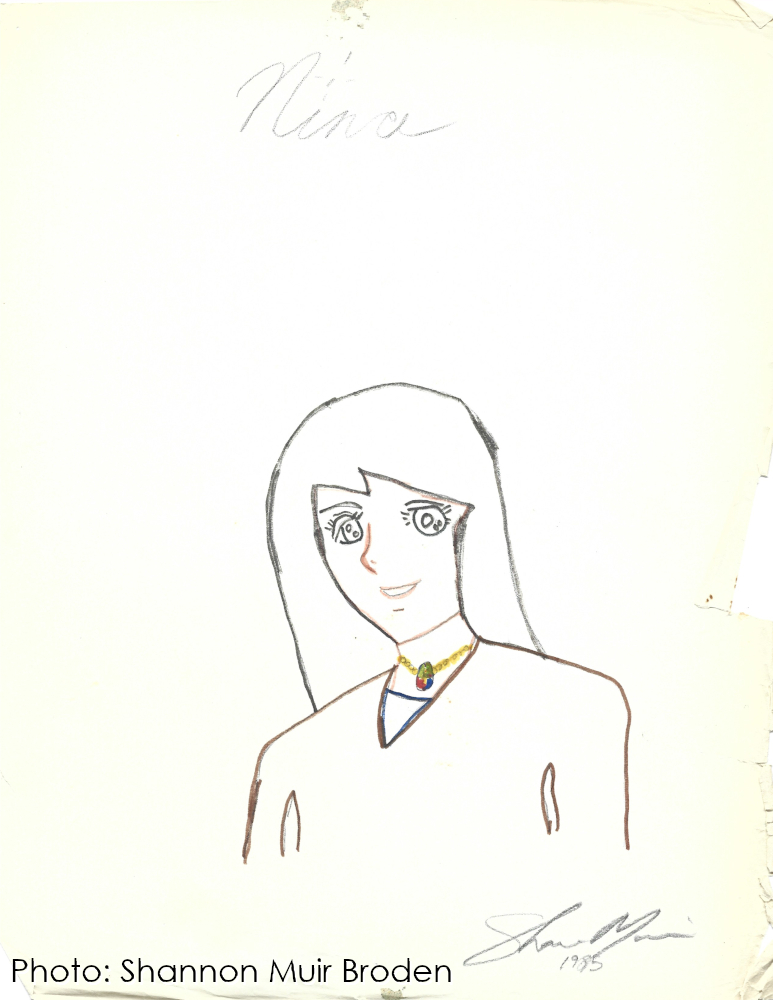
I actually sent the Nina story to World Events in two different forms. First, I wrote a prose story of “Nina and the White Lion” as an origin story to introduce her to the show. The White Lion was her secret destiny, which she alone was entitled to as Coran’s daughter. Also, I think I loved the idea of the character tension that would give Lance, given that he and Coran rarely got along, and all of a sudden Lance and his newfound daughter are spending way too much time together. Also, Coran would be expecting her to conform to royal protocols as she now is back among family, but Nina being unaccustomed to it and not wanting to be tied down, would have none of it. Additionally, the Whilte Lion would be her birthright, making Keith question where he stood as team leader. These commonalities played key roles in her and Lance finding common ground.
I sent that version of the origin story to the station that aired the show, who then passed it on to World Events Productions. In the meantime, additional episodes would air. Given we had the episodes with Coran’s son Garrett, this may seem a bit confusing. Bear in mind the version I sent directly to the television station that aired VOLTRON, was sent before I saw the two-part episode featuring Garrett. I quickly got over that with the idea that Coran had been married twice and Garrett’s mother was his second wife. Life went on, and I didn’t see my idea as being impossible. If you believe in what you do, you’ll find a way.
What ultimately came back was a nice fan letter supposedly signed by the pilots, as if I was a younger viewer. However, what I really wanted was review and feedback of my stories. The items sent to me included one key item, which was the direct address of World Events Productions. While waiting, my younger sister Lesley and I came up with over twenty story ideas involving Nina and other new friends that she then introduced the Voltron Force to. Those twenty or so stories were packed up and sent directly to the desk of Peter Keefe at World Events Productions.
As I worked on Nina’s backstory, I needed to figure out where she came from. I could use an existing planet or make up something. Names had been dropped of planets throughout the show, and once the World Events-produced episodes – the ones that weren’t adapted from BEAST KING GOLION – started showing up, things were split up into quadrants. That helped me place some planets, but others could go anywhere. Obviously, at fourteen, I had some basic grasps of science, but that was about it. The placements that weren’t story dictated I tried to have some sort of process to. For example, I tried to only put one desert planet in each star system. This process was the genesis of what has become known as the Denubian Galaxy Starmap.
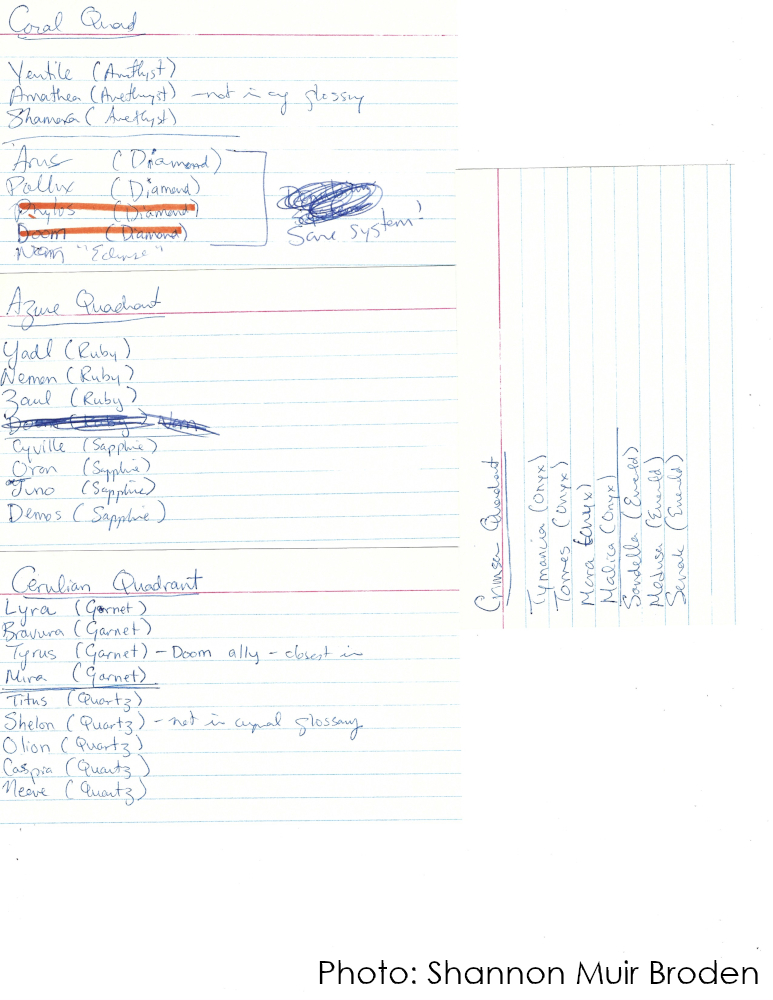
I started out writing all the information down on cards, and looking at them now, some things don’t make sense. For example, I have Shamara as “not in the original glossary,” which would be the list of planets actually referred to in the series that I wrote down. Yet, Shamara actually is because Cryo, its third moon, is where the Doom clone of Coran’s son lands. The cards also show Phylos and Doom as crossed out but not rewritten anywhere else. The show clearly established Doom in the Crimson Quadrant, and Phylos was a weird case because it was a planet with an elliptical orbit of a comet that comes in Arus’ airspace. Count Zane of Phylos mentions the Coral Star System, so from that fact I originally put Arus, Pollux (Romelle’s homeworld) and Phylos in the Coral Quadrant. This carried through to the actual star system maps that I would later draw for myself, complete with legend keys by letter. All this work was done in early 1985.
For anyone who has ever seen the Starmap as it evolved and was endorsed by World Events Productions, there are major differences. Planets are removed, some because they were my original creation and some I think because they were such minor references they didn’t want to crowd the art. The largest is that the Coral and Azure quadrant names are flipped. I don’t remember if the reason was that the scripts already done for VOLTRON: THE THIRD DIMENSION had Arus in the Azure Quadrant and I adjusted the map, or if World Events made the change on their own, but since I made no handwritten revisions to my master map from the 1980s, I don’t think it was an error on my part in the original data collection. I honestly forgot about this discrepancy until I pulled out the information for this article.
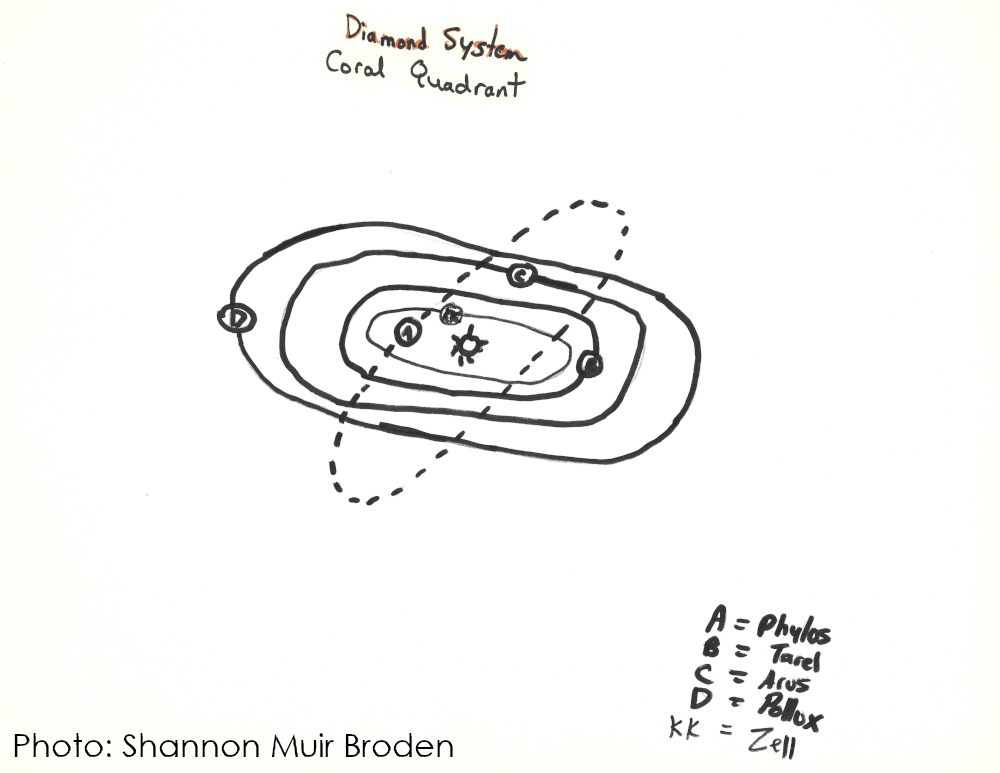
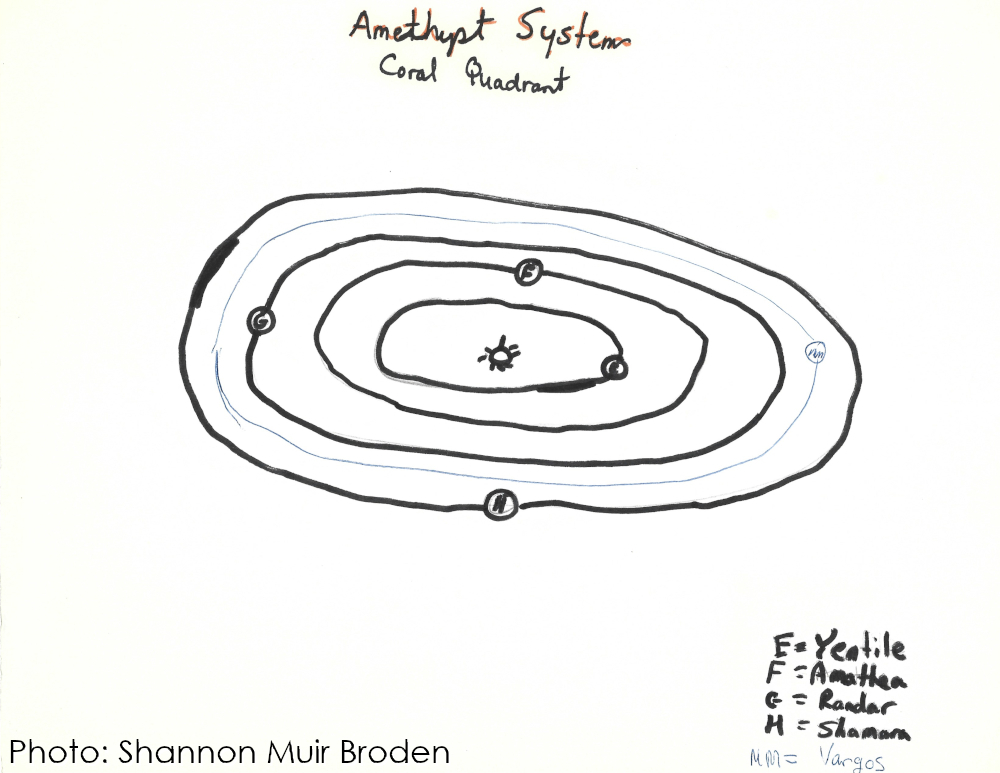
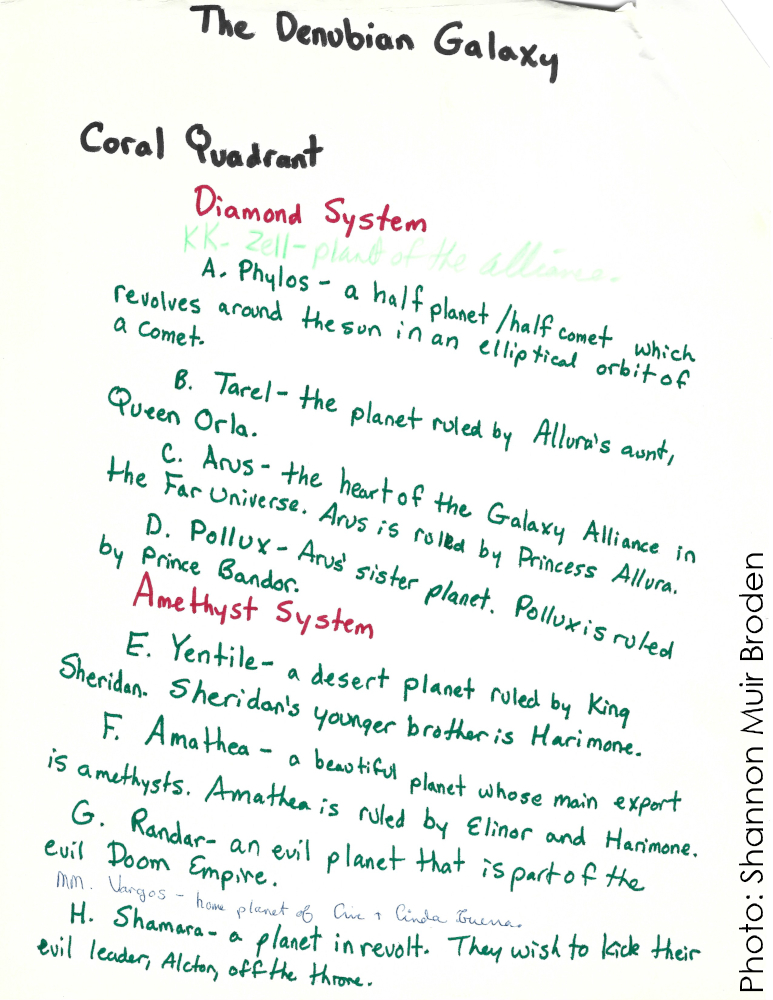
As much as I know and contributed to the history of the Denubian Galaxy, I think it would be hard (but not impossible) for me to work on any version of the VOLTRON series – either in the past or anything the future might hold – if Nina weren’t a part of it. Regardless of how the Starmap is laid out, she is the center of the emotional universe. The Starmap may have happened because of her, but in the end it would become the vehicle to open many other doors.
Greg Tyler: Your involvement in Voltron transcended from television viewer to something more. When and how did that happen?
Shannon Muir: It took several attempts, the first sent to the station airing the show and the second sent directly to Executive Producer Peter Keefe, to get the feedback I wanted on Nina’s stories – all 20 plus premises of them the second time around. Like I pointed out earlier, I didn’t like being ignored or receiving ‘no’ for an answer. What I would get, after a lot of waiting and practically giving up, was the two-page letter from Marc Handler that changed my life. I still remember vividly the day the letter came, and my mother was taking a very long time to get the mail. I went to look out the front window, which has a good view of the mailbox. She stood staring at an envelope, and even from that distance, I recognized the logo of World Events on the front. Even though it was cold and snowing, I threw open the front door and told Mom to hurry inside. Inside, we read the letter together. Though VOLTRON was long done and they were in production on SABER RIDER, Marc Handler gave me the feedback I wanted on my stories. Now, someone other than my teachers and my supportive family saw something in me. My Mom’s been gone two years now, and I miss her every day.
The die was cast. At fourteen years old, my future was set, or so it seemed. I decided to study radio-tv with the hopes of learning to be a professional animation writer. Though I moved on, I didn’t get rid of anything I’d compiled while working on the Nina stories, including the Starmap.
Greg Tyler: How did you become involved in Voltron fandom?
Shannon Muir: There are two ways to look at this question. One is the state or condition of being a fan, and the other is being part of the greater Voltron fandom, collectively. I’m going to assume you mean the latter. We’ve spent a lot of time already on the former.
It completely relates to my choice to take the Denubian Galaxy Starmap online. While I was preparing to move to Los Angeles in 1996, I came across my notes from the 1980s when I was packing and decided to put the Starmap online, as I had noticed other people creating early sites on AOL and GeoCities and similar. I had my own AOL account, so I created a text-based version of the Starmap there. Years later, it would move to Dueling Modems when AOL took away their hosting services, but only because I realized I had a following that actually cared about what I had to say. I stopped updating it in 2011 because I lost access, but the site is still out there. Weird.
My goal had been to close the door on my “fan” past, but not waste any of the work I’d done in hopes it might help someone else. Obviously, I didn’t accomplish that, but deciding to take the Starmap online emphasizes my innate drive to want to help others and “pay it forward”. In my eyes, I was helping the fandom before I shut the door that I wasn’t – fortunately for me – able to close. If you had told me twenty-five years ago that making that one decision would change so much of my life, I would not have believed you.
Greg Tyler: How did the onset of the Internet affect your Voltron-related activities?
Shannon Muir: Early on, once the Starmap went online, I did try to interact with the fandom that started to grow and reached out to me as my website was considered one of the more comprehensive ones at the time in terms of information. I do remember being involved briefly in an online world-building situation where I remember designing a daughter for Lance (noticing a theme here?), but my professional obligations as I began to work more in animation made me feel like I needed to step back a while. The beauty of that interaction is that it allowed me to realize that there were other people out there just like me. With social media, I think we take that a lot more for granted now.
Greg Tyler: Aside from reruns and re-packagings, such as THE NEW ADVENTURES OF VOLTRON, Voltron was a sleeping lion of sorts for more than a decade. What was going on in your life during that time?
Shannon Muir: A lot changed between the launch of the original show and VOLTRON: THE THIRD DIMENSION, which is what it sounds like you’re referring to here.
Once I entered tenth grade, I petitioned the school district to take junior and senior English in the same year so I could take multiple college classes my senior year, way before programs like this were a regular thing. They kept telling me I couldn’t do it but gave me no good reason why I couldn’t. I asked them to let me try and fail, and to their credit, they did. I placed third in the AP 12th grade English class and got a “3” on my AP English Lit exam. I say this not because I want to brag, but because it is another example of my unwillingness to take no for an answer.
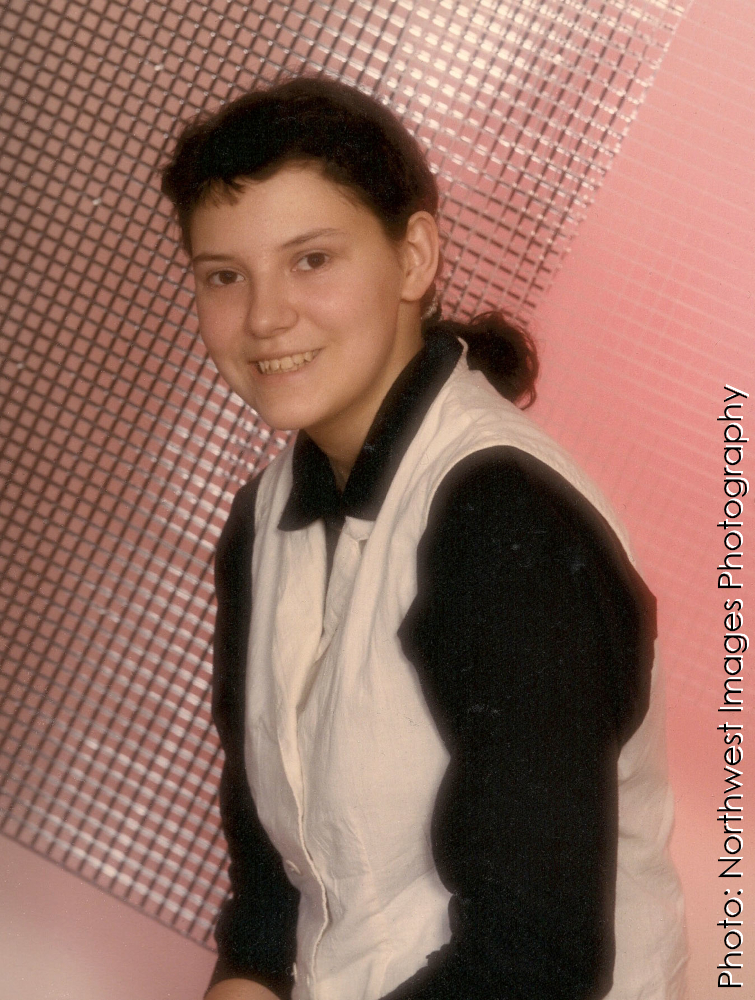
My first job was to be hired for the school district to input our entire school library card catalog into a computer system. I got into the radio-tv classes I wanted at age seventeen. Everything seemed to be going my way.
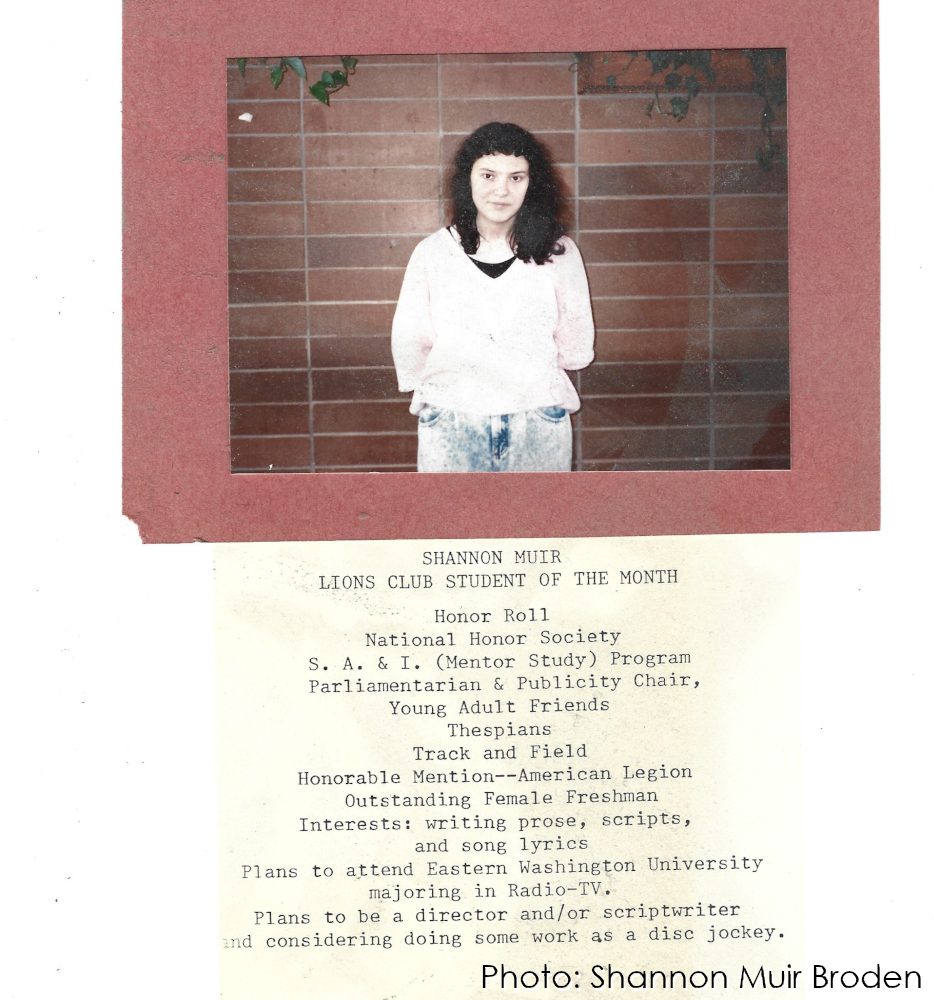
Social interaction wasn’t high on my list, as you probably figured out. I had a good male friend I’d become close to in the sixth grade, and even though we moved to different parts of the country after my Dad retired and his got sent elsewhere, I didn’t see myself with anyone else but him. I think it was junior year when he came out to me on a phone call, and now I found my vision of what my future would be upended. I saw myself achieving professional goals with this particular person by my side for years. Now, I didn’t know what that part of my life held.
That uncertainty opened the door for some very difficult things.
I wound up being taken by one of my college classmates to my senior prom, because no one from my high school asked me, probably because I’d shown no interest in dating anyone or anything of the sort. The fact this person even asked me led me to believe that he cared more about me than he probably actually did and resulted in a very disastrous first relationship that I’m surprised didn’t crush my spirit, as I had to continue to deal with him in our very small department for the next two years. His younger brother died the summer we were dating, and he reunited with someone from high school at the funeral, which I also attended but didn’t meet her at the time. The result was he dumped me and very shortly was engaged to marry her. He would bring her around the department all the time, including coming in with her to edit video production footage when I was the only other person in the building, because I had a Saturday morning radio shift. That’s just one example of many. What should have been an enjoyable time for me in life could largely be summed up as a nightmare.
There was a couple of bright spots in all of this. The chair of the department asked me to work with him to start a new type of radio station, one that would only service the campus dorms. We did a survey, presented the results to the student government, and got it off the ground. Also, I was given the chance to start a new program on the 10,000 watt jazz station that the University has called “Women of Jazz,” that although it has shifted timeslots on Sundays, continues on the station almost thirty years later. The biggest memorable event of those two years was getting a nomination for best Student Drama Script at the National Broadcasting Society-Alpha Epsilon Rho Student Production Awards for a script called “From the Fatal Heart,” which had been produced on campus the summer of 1991. Spring of 1992, the department paid my way to Washington, D.C. for the awards ceremony. Honestly, looking back, that whole situation was kind of funny. For example, no one told me this was a “black tie” level event until after I got there. Fortunately, I did have a credit card and had to run out and find a Macy’s to buy something. Bear in mind there were no Macy’s in my neck of the woods back home, and the most I knew the name from was New York and the Thanksgiving Day parade. The reason I mention this event is that even though I didn’t win, I did come back to reactivate our own dormant chapter of the organization and become its President, and I need to set this up for the next key piece in the story.
By Fall 1992, my ex-boyfriend and his at-that-point-wife were gone. I had just turned twenty in July. It was supposed to be my last quarter of school. I’d made it through. Soon, I’d be done and could go after whatever I wanted next.
However, that was not to be.
Looking back, I think that emotionally and physically I’d been under so much stress from the relationship interaction over the course of two years that once I settled into school again in the Fall, and the atmosphere wasn’t the same, that the tension just decided to let go. It was gradual, but I didn’t see it coming. A toe in my right foot kept giving me problems in twitching uncontrollably. I thought I just hurt it and tried to be careful with it. It kept doing it. I ignored it.
One night, I was eating dinner with my family when it really started bothering me. It wouldn’t stop. I told them I had to sit down on the floor and take a look at it.
The next thing I remember was waking up looking at the ceiling, my Dad and a paramedic over me. I took my first ambulance ride that night. I’d had a grand mal seizure. No one could figure out why. They gave me medication but initially overmedicated me so bad I had to withdraw from some courses and kept falling asleep on campus so I missed others and barely passed. They’d had to replace my hosting spot on “Women of Jazz” and I never got to return to say a proper goodbye. Eventually the medication issues got straightened out, but the damage was done. All my dreams as I’d seen them, all my plans as I’d made them, slipped away from me. Only twenty years old, and I was completely directionless.
Clearly, I found my way back, but it was a long road that wouldn’t pick up again until 1993, and a chance event that would motivate me to reach out to Ted Koplar, the late President of World Events Productions. Again, everything points back to a dream and a Starmap.
So not having a plan, I stayed in school two more years and got a double B.A. in English – Creative Writing, which ended up being an emphasis in poetry, when I got the rude awakening that genre fiction wasn’t appreciated, which of course was what I was raised on and liked. But even this period had upsides. For one, my sister started taking classes at the University during high school, just like I had but not as many. Even though I had stayed to double-major in English, I intentionally took some of the television workshop program classes just so I could work with her. The dorm radio station I helped bring about would become a place where we did radio shows together right up until I graduated. Lastly, I would be the reason that my sister and her husband met; I knew of him from the English department where he was an English major and a Radio-TV minor. November 2021 they will be married for twenty-five years. So, there were good things that came out of those very bad events.
Now to get back to how VOLTRON factors into all this. Remember National Broadcasting Society-Alpha Epsilon Rho? I submitted to their competition again, this time a script that had not been produced. I wasn’t optimistic about it, but for my own sake I needed to try. Again, I was a finalist, and again I flew out to the National Convention – this time held in April 1993 in St. Louis, Missouri, home of World Events Productions.
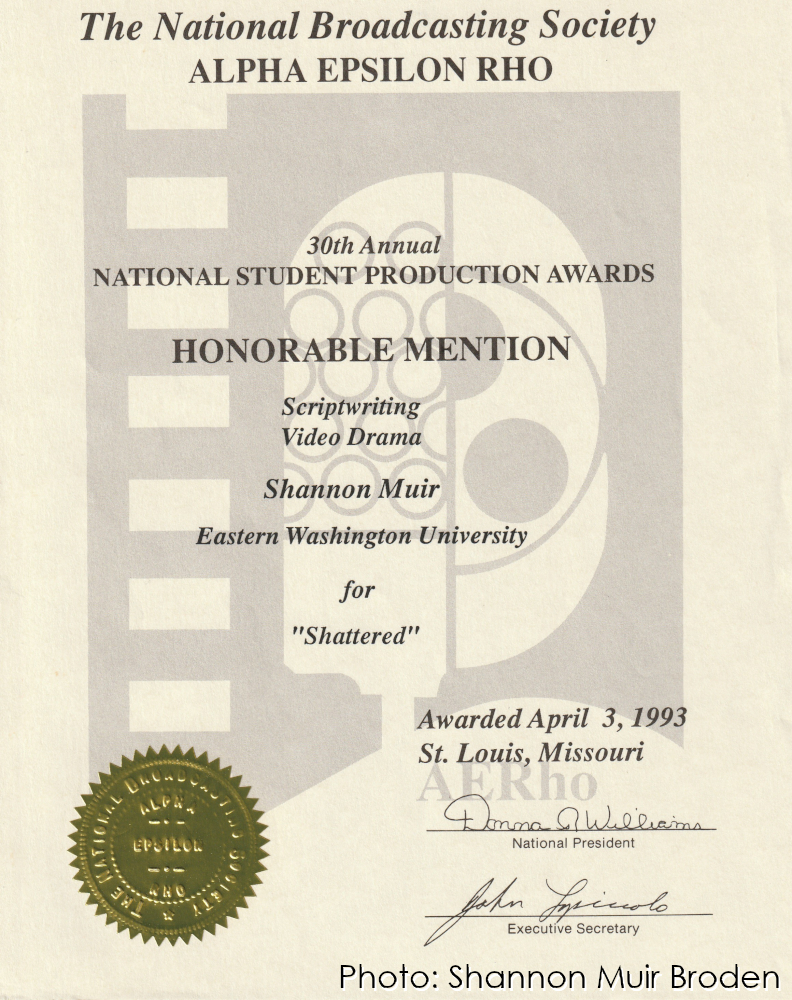
For the second year in a row, I did not win. This mattered more to me because after what I’d been through, honestly I needed the encouragement. What was worse was the next day. I remember going down the escalator at the hotel where I could see the St. Louis arch out the windows. A couple people got on behind me and started whispering about how easy it was to get an award in the writing categories because so few people enter. Whether it was fact or just to be malicious I don’t know, but it stung. I remember looking forward without acknowledging them as the escalator continued to go down, and I could see the St. Louis arch out the window. I was reminded where I was. At that moment, I felt moved to contact World Events Productions again. Peter Keefe had moved on by then, but I knew Ted Koplar was there, so I wrote him a letter asking about reviving VOLTRON in novel form similar to the ROBOTECH novels. He wrote back asking me to call him. We talked, he wanted to fly me out there and talk more, but clearly his focus was on television, and finding ways to re-release the original show. I went to people for advice, and the advice I got was largely against it, from airfare is not enough to just give away good ideas to genuine concern for myself and my welfare given the last several years I’d endured. Sure, I’d bounced back, but there was still a chance of things going south. Most of all, my writing was the area where I sought reassurance. I would up writing a script based on one of the ideas I’d technically run by them in the past through Marc Handler and Peter Keefe called “Soldier’s Song,” about a USO-like singer that the space explorers first saw at the Academy coming to Planet Arus. While music is inherent to a lot of anime (and clearly was an undercurrent in several episodes of VOLTRON FORCE), I chose the topic based on the background of my studies and interests. I pulled out the script again recently, and while I can find weaknesses in a lot of it, some of the early parts made me laugh quite a bit, such as a sequence that has our heroes first meeting at a concert while at the Academy.
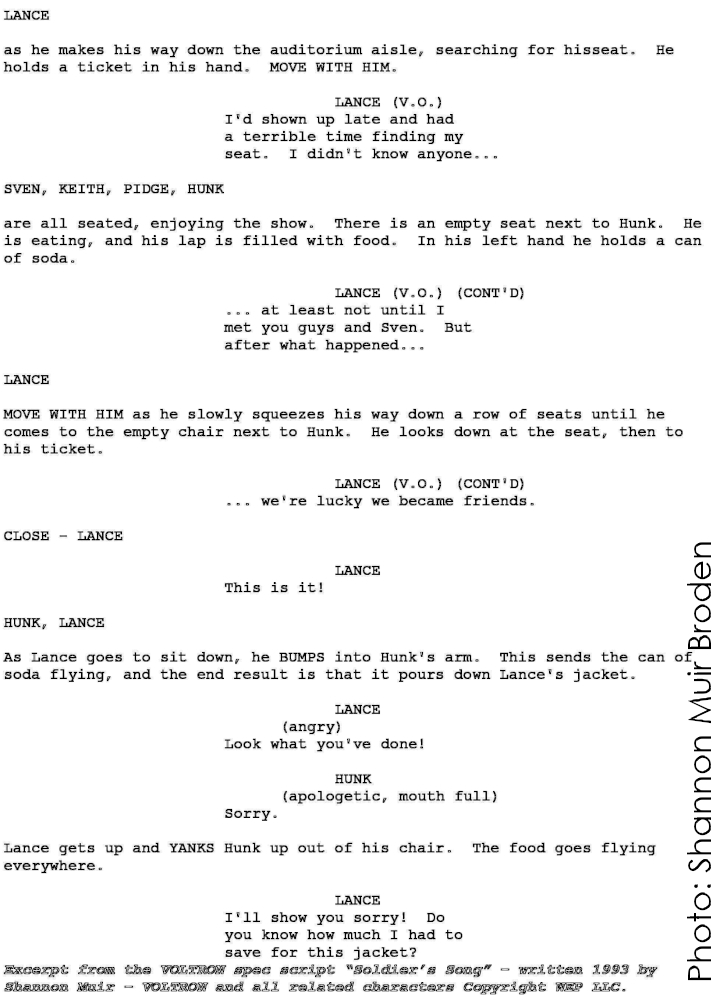
I never did hear back from Mr. Koplar, but it is interesting to note that VOLTRON: THE THIRD DIMENSION happened within five years of this conversation. I do not know if there is any connection. What I do know what making that contact in 1993 would pay off years later. Life tends to surprise me a lot like that.
Not hearing him from was frustrating at the time, because I wanted that validation after everything I’d been through. However, I persisted, and I’m here today to talk about it. Truthfully, it wasn’t Ted Koplar’s job to give me validation, or anyone else’s. The only person who can get you out of a place like that is yourself.
Ultimately, I moved to Los Angeles, as we discussed earlier. Actually, it wasn’t originally known if I’d stay. A now longtime friend and mentor, Christy Marx – and how I first met up with her is another long story on its own – knew a friend who’d be traveling to Hawaii for a week and needed someone to house-sit, and she thought that this would be a good way for me to go from my small town to Los Angeles and see if I really wanted to stay. This person was the late Larry DiTillio, co-creator of the original SHE-RA and fellow animation writer. Obviously, it worked out and I stayed, so my Dad packed up a U-Haul and drove all my stuff down here. I was pretty certain I would remain, so I’d packed up everything and left it ready. Mom pulled a muscle badly trying to get into the U-Haul and didn’t come down with him, so she never got the chance to see me here. My Dad hasn’t been back to California since; I’ve always gone back to Washington State for twenty-five years, at least once a year (excepting 2020, of course).
Christy would also recommend another friend of hers to keep an eye out to help me early on because she would be traveling extensively and not be easy to contact. She would introduce me to Richard Mueller, who is probably best known in animation circles for working on THE REAL GHOSTBUSTERS animated series. Through contacts he had, I would find out that Adelaide Productions was working on a first season of JUMANJI: THE ANIMATED SERIES and needed a Production Assistant to get them through the last couple weeks of the season. With my money almost gone, I decided a couple of weeks working on an animated series and then moving back to Cheney would at least mean not going back a total failure, so I said yes. Taking that job opened the door to being promoted and starting work on the two-part pilot for EXTREME GHOSTBUSTERS, and what might have been a good career there.
I did spec scripts for both JUMANJI and EXTREME GHOSTBUSTERS. Peter Gaffney from JUMANJI and Jeff Kline from EXTREME GHOSTBUSTERS both took the time to look at them. I got a lot of notes, especially where I needed improvement. One of them actually turned out to be similar to a pitch that was actually produced, the EXTREME GHOSTBUSTERS episode “Temporary Insanity” by – wait for it – Richard Mueller. I hadn’t told him what I’d shown Jeff Kline, but given the similarities and I did know him, I asked for the script to be reassigned to a different Production Supervisor.
What I learned was I needed to learn more to be a better writer. What I did not learn was that it is best to keep a day job, especially in the industry you love, while doing this. So, without anything lined up, I quit working on EXTREME GHOSTBUSTERS once all the shows shipped but before everything came back for post-production. Believe me, I paid for that choice. I didn’t understand how hard getting another job would be, and of course people were reluctant to help me, since I was the one who walked away. I didn’t fully understand that then, but I do now.
I did temp work in a lot of odd places for over a year, while putting out resumes to any ad in the trades that made sense. Finally, through an ad in the Hollywood Reporter, I ended up as the Administrative Assistant and later also the Book Buyer for The Writers Store, originally known as the Writers Computer Store because they’d been trailblazers in selling and repairing personal computers for industry writers. I worked there from 1998 to 2000, which is the same timeframe as VOLTRON: THE THIRD DIMENSION. During this time, I also was able to take a UCLA Extension class that lasted about six months geared to animation writers, following the whole process from script to cel. My teachers were Kevin Hopps and Greg Weisman. We were assigned different instructors to be our “story editors” through the course, and I ended up being assigned Greg Weisman. If you’re curious, I did a spec (short for “on speculation”, basically a sample script for those unfamiliar with the term) for MEN IN BLACK: THE ANIMATED SERIES. Needless to say, I got kicked around a lot more, Greg does not pull punches with his notes. Yet, it was what I needed, and this time I was ready for it.
Greg Tyler: Eventually, Voltron was needed once more, and VOLTRON: THE THIRD DIMENSION was the result. What were your thoughts on that show?
Shannon Muir: As I mentioned, VOLTRON: THE THIRD DIMENSION hit the airwaves around the time I was taking improving my writing skills seriously again. An interesting bit of timing, now that I look back at it.
Before I get into my thoughts about the show, the story has to come back to the Denubian Galaxy Starmap. During the run of VOLTRON: THE THIRD DIMENSION, I received contact from Bill England, the graphic designer at World Events Productions. A couple of years ago, I ran across my notes from our original phone conversation, hurriedly thrown in a box at some point when I moved apartments around 2008.
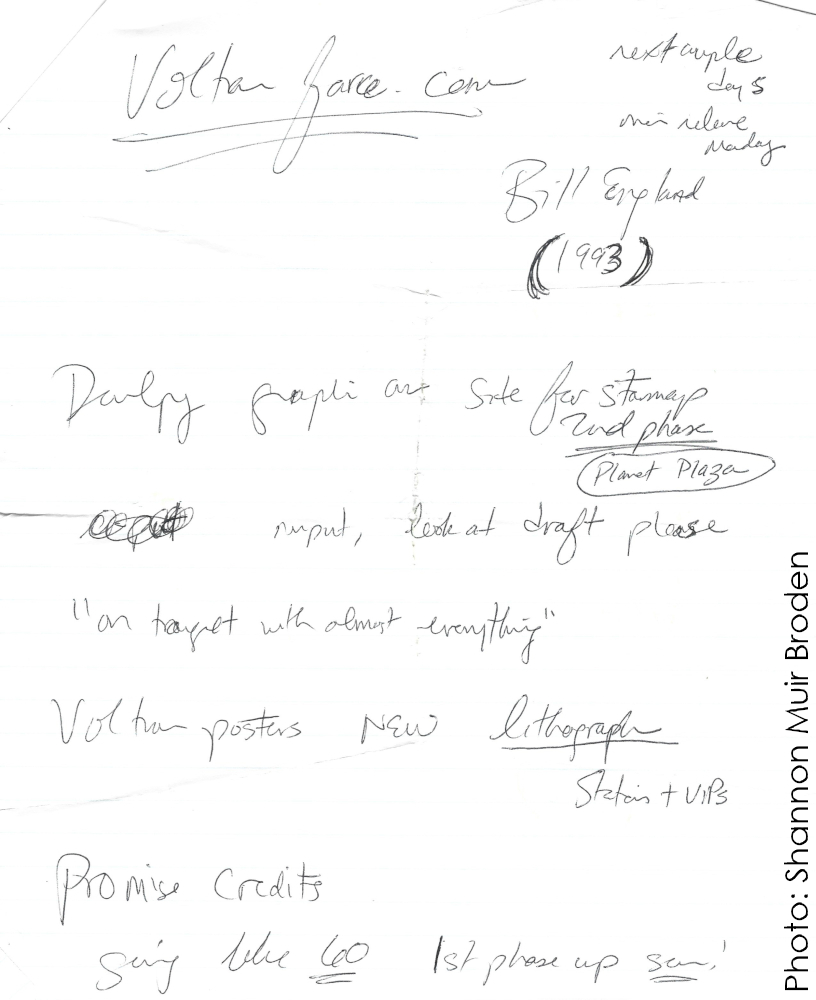
Note the date in parentheses under Bill England’s name. 1993. The year I contacted Ted Koplar. If I remember correctly, he referred to being aware of me because of that 1993 contact with the company.
Bill England contacted me about partnering up with World Events Productions to create the “canon” version of the Denubian Galaxy Starmap, which he would render graphically. The notes also talk about a multi-phase approach involving the Starmap. Getting in on “Planet Plaza” on their website is listed as a second phase, with “Planet Plaza” being the place to locate the Starmap on the VOLTRON: THE THIRD DIMENSION version of the website after you came to the main menu with several options. The first phase notes involve creating a lithograph for stations and VIPs. I only know of one lithograph that was ever distributed, and it was the one sent to me.
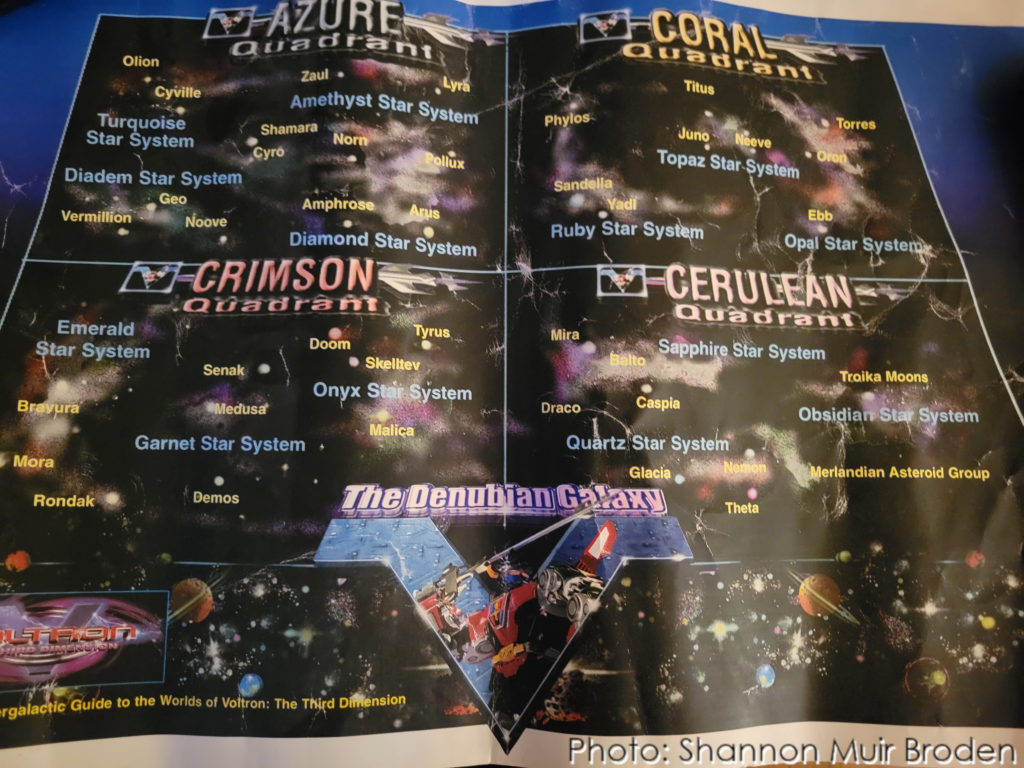
The condition you see it in is roughly the condition I received it in, unfortunately. What I would love to find out if anyone has ever seen another lithograph out there of the Starmap, and how if at all they were distributed.
It’s crazy that I posted the Starmap to try and close the door on my “fan” life and separate it from my “professional” life. Yet, over and over, the Starmap keeps bringing me back. I’ve finally made peace with that, but it took a long time.
It’s also an interesting piece of trivia that information in the VOLTRON: THE THIRD DIMENSION episode “The Trial of Voltron” is clearly based on that Starmap, something I later confirmed with Marc Handler.
I was interviewed for a VOLTRON: THE THIRD DIMENSION documentary that was shown at Comic-Con International: San Diego but ended up on the cutting room floor; I said in that interview that the characters were the reason VOLTRON endured and I don’t think that went with the focus of the documentary and therefore was omitted; however, I cannot help but note the “shipping” community that has grown for various incarnations of the series has proven me right.
In terms of what I thought of the show, animation-wise it was innovative for its time and my now-husband and I met some great people who worked on the show along the way. The thing I had the hardest time with involved Keith and Allura acting like they’d never had any interest in one another. I just ultimately accepted that it was unspoken that they’d tried something that hadn’t worked out, and both ended up as people who put career over personal life. Again, while the mecha interested me, characters against the storytelling backdrop always remained the primary focus. While some of the new theories it opened up about the origin of the lions I found compelling (trying not to say too much to avoid spoilers for anyone interested in seeing the show), I generally didn’t feel it had the depth of character it could have. VOLTRON FORCE came much closer, and let the characters evolve logically given roughly the same number of years having passed as VOLTRON: THE THIRD DIMENSION assumes.
That said, I would not have passed up a chance to write for the show, and that did almost happen. As I said, I met Mike Young as a result of shooting that interview because it was done at Mike Young Productions. If there had been another season, the likelihood that I would have at least gotten a chance to pitch is high, based on the conversations of the time. Yet, that didn’t come to be, which is just the way this business is sometimes. Nothing is a sure thing.
Greg Tyler: In the years following VOLTRON: THE THIRD DIMENSION, Voltron enjoyed several comic book incarnations, and, to date, two additional television incarnations — VOLTRON FORCE and VOLTRON: LEGENDARY DEFENDER. What are your thoughts about those?
Shannon Muir: I’m a believer that each version can co-exist independently. VOLTRON: THE THIRD DIMENSION has an episode “Consider the Alternatives” and over time, I’ve just kind of made that my mantra. Be open-minded and consider the possibilities and what-ifs. I watched VOLTRON: LEGENDARY DEFENDER as it came out, and only more recently binged VOLTRON FORCE, which I didn’t see when it first came out. The reason I didn’t watch or speak up about VOLTRON FORCE wasn’t out of any sort of dislike of where the show was going. In fact, I’d gone so far on paper – though World Events never saw any of this work – to map out thoughts about a whole new generation of Voltron pilots based on the actual descendants of the original team, back when I was still a teenager. The issue there was that I worked for Nickelodeon’s Virtual Worlds division at the time (they’ve since sold this part of the company), and given Nicktoons’ partnership with the show, it was safer to keep my distance, especially if they’d brought a pitch for a multimedia online game to the office. It concerned me enough I actually consulted our legal department about it, but our attorney I don’t think quite understood my concerns. In the end, they never came to pass, but better to err on the side of caution. Actually, it turned out the concern may have been a bit too much, as I actually found myself caught up in a mass layoff at the Virtual Worlds Group right before Comic-Con 2011, about six weeks into the show airing; afterwards, I threw too much effort into finding new employment to keep up. Having watched it in 2021 in its entirety for the first time, I do like the growth in character arcs as I mentioned earlier, and genuinely felt disappointed that the series ended on the cliff-hanger it did, though I otherwise believe the character progression up to that point was handled very strongly and logically. I wish they could find a way to resolve this story in some medium, and I’m not counting the “epilogue” in the 30th anniversary book, because that left far more questions than answers.
Later on, due to professional memberships I had at the time, my husband I were able to screen the pilot movie for VOLTRON: LEGENDARY DEFENDER, “The Rise of Voltron,” on the Dreamworks lot. The biggest surprise for me would not be the movie, but the end credits. Throughout, I saw names I knew of people I actually worked with but most I’d lost touch with. It’s important to know that a number of people at that time came to Dreamworks Animation under Mark Taylor, who before that served as Head of Production at Nickelodeon Animation, but some of them go back farther when Mark Taylor was in charge of Production at Adelaide Productions, since evolved into Sony Animation. That’s where I’d worked with the some of the names I saw on screen, when Mark Taylor gave me my first job on JUMANJI: THE ANIMATED SERIES, which would lead to being on EXTREME GHOSTBUSTERS. As I said earlier, I left Adelaide because I wanted too much to be a writer; the small-town girl didn’t understand how networking or many other aspects of this business worked.
Some days I wonder if I stayed at Adelaide if my path would have ended up at Dreamworks on VOLTRON: LEGENDARY DEFENDER. I try not to entertain that thought too often, because I find it depressing. Yet, even in that missed opportunity, I have other touched or had near misses with every iteration of VOLTRON.
As I said, I do my best to respect each storyteller’s take on the property. I know some people have had disagreements with certain aspects, and I think it is good that those voices have been raised. I also have one point at issue I’d like to talk about that it actually bothers me has not come up, and I believe this strongly comes from having worked on an animated series like EXTREME GHOSTBUSTERS where we went above and beyond to make Garrett one of the most able of the cast though he happened to be in a wheelchair. I am not comfortable with the fact that Shiro needed to be given some form of invisible but debilitating illness to move his plot along and treated as a throwaway to move the plot and not an ongoing aspect of his character. There are so many people out there today that struggle with issues like Shiro was depicted with, that people don’t realize they have them, that are not simply throwaway or less than adequate. While it would be true Shiro would not have been able to stay in the service if such an issue arose (my Dad and I actually had some detailed conversations on this at the time, though he didn’t actively watch LEGENDARY DEFENDER, he did understand my curiosity about military accuracy), there should have been some other means to get the plot to where it needed to be or write a character (Shiro or otherwise) where this issue was embraced.
Going back to you asking about my own fan fiction, I mentioned having worked on a next generation of Lion pilots. Since I’d no longer pursue this specific road – largely because of a direction one of the series did go in – I’ll share an example. In those 1985 notes, the next generation of Blue Lion was piloted by Kara, who was probably my favorite character of that group. The name spelling generally comes from countries like Iceland and Sweden, so with those hints you can probably figure out whose daughter she was. She did have one other thing about her that was distinct, and while my notes vary because I never really decided how far to take this, she either went from having leg braces to having prosthetic legs, somewhere on that spectrum. Bear in mind I’m writing these notes as a teenager in the 1980s, not to appease some corporate executive or mandate to be more inclusive. It still amazes me all these years later how far ahead some of my thinking was.
I don’t have too many comments on the comics, save one in particular. The hardest thing, and I struggled with this when it came to the Devil’s Due comic rendition as well, was totally having to put any preconceived notions of what the characters should be on the shelf. The Devil’s Due series was a real struggle for me, especially casting Lance as a criminal more than just a troublemaker with issues. However, over time it grew on me, and if you want to see my commentary on that you can read it in the letters column of the Image/Devil’s Due Issue #5 comic. I would later meet writer Dan Jolley in person in 2004 when he signed my trade paperback for REVELATIONS during an appearance at Comic-Con International: San Diego, and we had a good discussion about it all. It really opened my eyes to be accepting of other ways of looking at the characters, which I suspect made it easier for me to deal with a reboot like VOLTRON: LEGENDARY DEFENDER.
Greg Tyler: How has your interest and involvement in Voltron influenced other parts of your life?
Shannon Muir: I wrote an animation textbook to help “pay it forward” after all that was done for me, including a mini interview with Marc Handler, called GARDNER’S GUIDE TO WRITING AND PRODUCING ANIMATION, the name of the publisher being the Garth Gardner Company. The book ended up happening because I had a challenge breaking back into animation after taking time off for grad school, which I became interested in doing after getting laid off from Nickelodeon’s INVADER ZIM in 2002. I’d always wanted to get a master’s at some point, but part of the reality in doing it when I did was being able to still live in California and pursue my dream. My student loans kept me afloat and I’m finally within reach of paying them off. Considering I graduated in 2005, that’s a while. I’ve met professionals in the field who tell me they got into the business in part by reading the book years ago. That is something I still can’t get my head around.
So how else did VOLTRON impact my life?
When Peter Keefe – the Executive Producer of VOLTRON: DEFENDER OF THE UNIVERSE and several other early World Events Productions series – passed away, I would find myself in a very unexpected situation. I was contacted by an animation writer I’d heard of but never met named Nicole Dubuc – whom I know much better now – and she approached me to be the person to speak regarding Peter Keefe at the annual Afternoon of Remembrance organized by the Animation Guild 839. At first, I kept insisting I wasn’t the right person. Surely there must be someone available who had worked with him. At the end of the day, everything came back to me. They wanted me to speak.
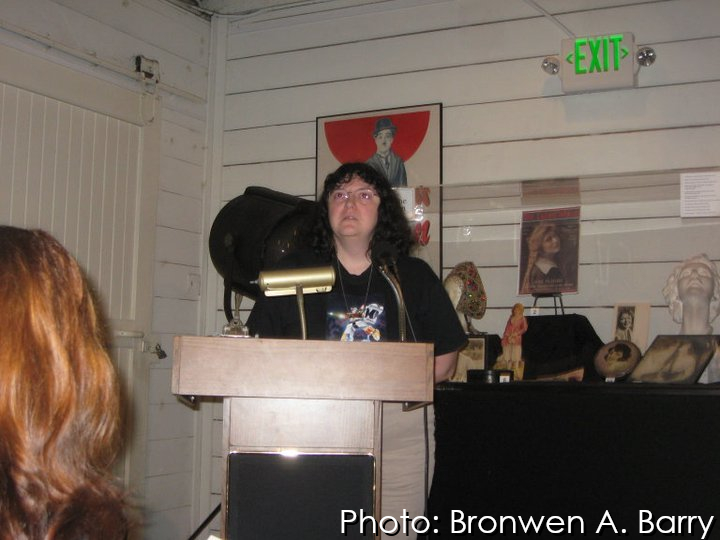
That was how I ended up being the one to speak about Peter Keefe at the annual Afternoon of Remembrance after his death, twenty-five years after I received Marc Handler’s letter. I gave that speech, first quickly running down Peter Keefe’s credits, followed by the day that changed my life when I got Marc Handler’s letter thanks to Peter Keefe forwarding all the ideas for Nina and the storylines surrounding her adventure with the extended Voltron Force in the Denubian Galaxy, and ending with the quote from Lance I gave earlier.
What I did not know was that Michael Bell was in the audience, and that he was scheduled to speak right after me about someone else. I almost didn’t notice the extended hand coming toward me down the aisle as Michael Bell finished his speech, but I’m glad I did. Michael Bell and I connected with a “high five” in the aisle.
The Starmap, of course, is what also led to being discovered for the LET’S VOLTRON Podcast by Marc Morrell, and the first show I did goes back to when the two of us met as guests diving deep into VOLTRON: THE THIRD DIMENSION in 2015, before you became co-host. I’ve loved every opportunity I’ve had to come on and do episodes, which has resulted in meeting even more people and some great friendships. Along the way, I hope listeners are learning things from my observations or stories. I hope I live to teach and “pay it forward”.
Greg Tyler: What else would you like to tell fellow Voltron fans?
Shannon Muir: When I did the Ted Koplar tribute audio record I sent in for the LET’S VOLTRON podcast – and I do have to say, it was easier to do that in my husband Kevin’s recording booth at home; I don’t think I’d have kept my composure on camera – I talked about finally meeting Ted Koplar and it being on my terms. My now-husband Kevin and I were at a Comic-Con panel at the Hilton where VOLTRON FORCE was announced, and I recognized Ted Koplar was off to one side of the stage. I’d seen his picture before in business articles I’d read over the years. As the presentation went on, I realized it might be the only chance I’d get to talk to him face-to-face. Since I never heard back all those years before, I did not know what reception I’d get. I didn’t even know if event security would let me get that close, though hopefully having a Professional badge I hoped might help. Yet, I knew I would never live with myself if I did not try.
As the event wound down, I whispered to Kevin to wait for me outside and pointed down toward Ted Koplar. As most people filed out of the presentation room in the Hilton, I made my way down the side aisle to where Ted Koplar was. I remember calling out his name, getting his attention. I extended my hand, told him who I was, and he remembered me. We didn’t talk long, I made sure to say thank you and best of luck with the new show. His response was short but very kind. I knew he was a busy man, I knew Comic-Con had to let the next panel in, so I didn’t stay or suggest any future contact. After all, World Events Productions already proved that they knew where to find me if they wanted to. What I did need was that one moment in time to say thank you one last time. Now here we are, twenty-five years after the Starmap first went online, and Ted Koplar passed away in April 2021. It left a little emptiness in my heart the day I heard; I suspect to some degree, it always will. Yes, other creative visionaries like Marc Handler and Franklin Cofod and many more made the original show what it was to become what it is today, but without Ted Koplar saying yes first, none of this would be here. My life as I know it would not be here.
I have since realized hearing how I told this story in the context of the podcast that it would be possible to infer that I could possibly hold a degree of ill will towards him until that point. I hope I made it clear by answering these questions that was never the case, particularly regarding Ted. What the difference was to me was being able to present myself as more than just a VOLTRON fan, yet I still championed and believed in the property. Given when I contacted him, I didn’t know anything about what my future held, I’m glad I found myself able to rebuild the world and start over.
I don’t know if I’ll ever get to work on the VOLTRON property in any more of a creative capacity than I already have. What I do strongly know is that I am irrevocably part of the narrative, part of the thread that seems to have connected iterations up to get us where we are today. I don’t know what the future holds for the franchise or for me, but I can say the journey of the last quarter-century – I still can’t fully process that – of being a professional living and working in Los Angeles never would have happened without what began with Nina and the Starmap. If one person’s experiences with a property as a fan can alter a personal universe so much, and I know I can’t be the only one, what sort of cosmic shift takes place when a lot of people are moved the same way?
I’ll leave you with another “small world” thought, one that isn’t Voltron specific, but is specific to where I grew up. There is another professional animation writer out there who is also from Cheney and now lives here in Los Angeles, but if I hadn’t attended the party at the home of a mutual friend I might never have found out. He didn’t know anything about myself or my story. Yet here we both are, and suddenly I felt a little less alone. Maybe, if we look at the things we have in common through fandom, that tiny little bit of what is the same, we might be all a little less alone.
I am the only person I know of who can say where they are in life ties back entirely to the original VOLTRON: DEFENDER OF THE UNIVERSE, as far as I know. If there is someone else, I’d like to meet them. I honestly don’t see how I would have the life I’ve had without it and know a Starmap guided my way, twenty-five years online and closer to thirty-five years since its inception. Maybe after twenty-five years of a professional life, this is the story I’m meant to tell… or maybe it’s a chapter in a larger tale. Time will tell.
Thank you to Lesley Muir Aeschliman for providing additional clarifications.
